The Hidden Danger: Understanding Refrigerator Suffocation
When a child goes missing during a game of hide-and-seek, the last place any parent wants to look is inside an old appliance. Yet tragically, refrigerator death has claimed too many young lives over the decades.
Refrigerator death occurs when someone—typically a curious child—becomes trapped inside an airtight refrigerator or similar appliance and cannot escape. What begins as innocent play can quickly turn deadly. Within just 10 minutes, a trapped person may lose consciousness. After approximately 25 minutes, death can occur. Children between ages 4-7 are most vulnerable to this danger, as they're old enough to climb in but may not understand the risks or have the strength to escape.
The mechanics of this tragedy are heartbreakingly simple. Once sealed inside, the limited oxygen supply rapidly depletes while carbon dioxide builds up. The thick insulation that keeps your food cold also muffles cries for help, making it nearly impossible for others to hear the trapped individual's pleas. This same insulation creates an almost perfect seal that prevents fresh air from entering.
| Refrigerator Entrapment Timeline | Effect |
|---|---|
| Within 10 minutes | Loss of consciousness |
| Within 25 minutes | Death can occur |
| Most at risk | Children ages 4-7 |
| Main cause | Airtight seals preventing air intake and sounds from escaping |
Pre-1958 refrigerators were especially dangerous because they featured mechanical latches that couldn't be opened from inside. While modern refrigerators use magnetic seals that can be pushed open with minimal force, abandoned older models still pose significant risks today. Other appliances like chest freezers, coolers, and front-loading washers present similar dangers.
The statistics tell a sobering story. Between 1946 and 1956 alone, at least 115 children died from refrigerator entrapment in the United States. This epidemic of preventable deaths eventually led to the Federal Refrigerator Safety Act of 1956, mandating magnetic closure mechanisms on all units manufactured after October 1958.
As specialists in safe cooling systems, we at American Mortuary Coolers have studied these historical cases extensively to ensure our products incorporate fail-safe internal release mechanisms. Our experience designing secure mortuary refrigeration has given us unique insight into balancing temperature control with essential safety features.
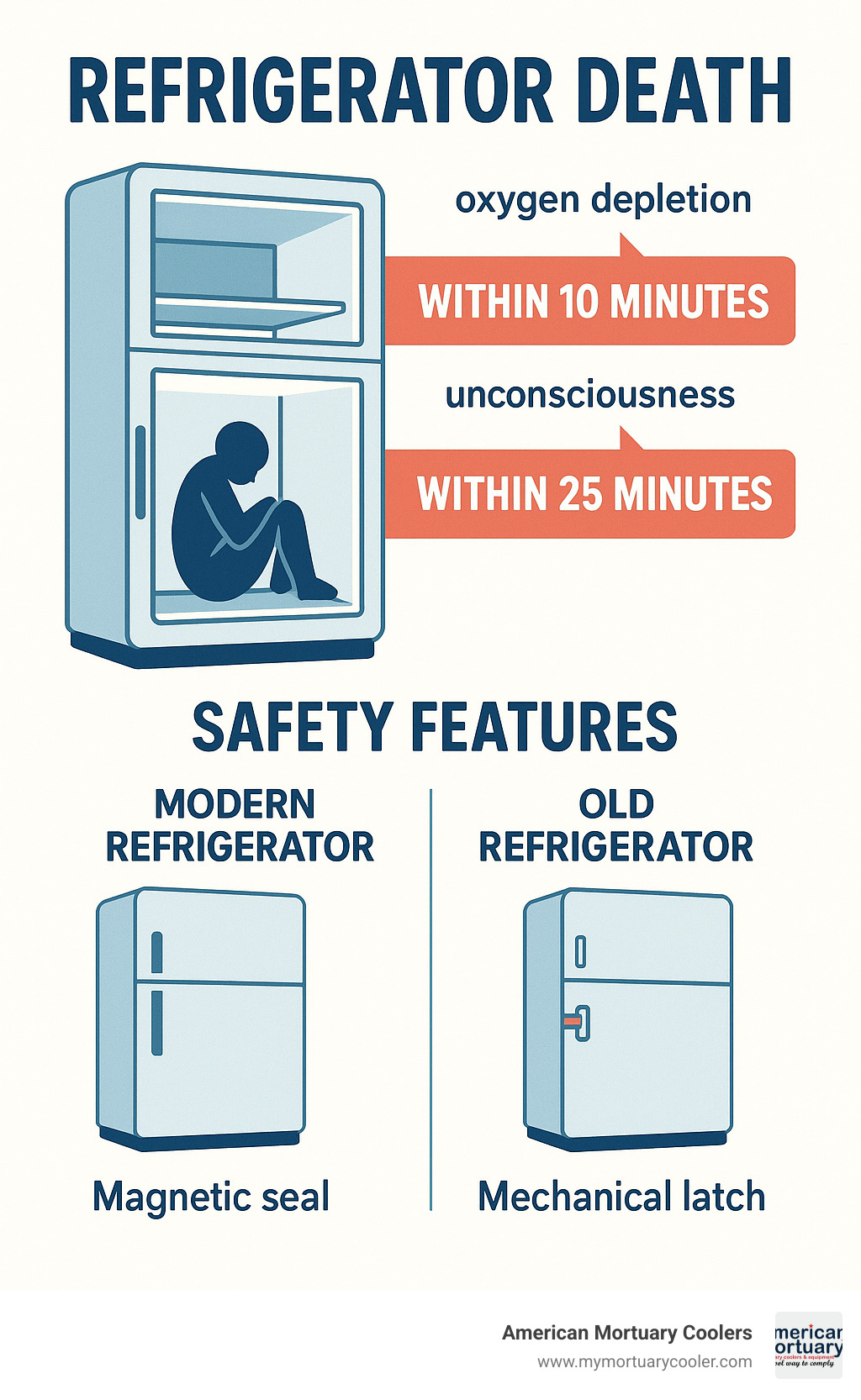
Recent refrigerator death cases continue to make headlines globally. In 2013, South Africa mourned the loss of children trapped in an abandoned refrigerator. Similar incidents occurred in Florida and Kyrgyzstan in 2019. Scientific research published in the National Library of Medicine continues to study these preventable tragedies to improve safety measures.
Refrigerator death glossary:
Understanding Refrigerator Death
Refrigerator death occurs when someone, typically a child, becomes trapped inside a refrigerator with an airtight seal. These tragic incidents happen due to a perfect storm of mechanical design and human physiology that creates a deadly situation.
Older refrigerators pose the greatest risk because of their mechanical latches that seal the door tightly from the outside. Once closed, these latches can't be opened from inside, creating what amounts to an airtight prison.
As Cecil Adams, who has documented numerous refrigerator death cases, explains it: "The problem with the old refrigerators prevented air from getting in and the kids' screams from getting out."
What makes these incidents so devastating is how quickly they turn fatal. When trapped inside, oxygen depletes rapidly while carbon dioxide builds up. A person loses consciousness in about 10 minutes, and death follows within approximately 25 minutes.
Children between 4 and 7 years old face the highest risk. They're independent enough to play on their own but too young to fully understand dangers or have the strength to escape. Hide-and-seek games often lead them to climb into refrigerators, unaware of the deadly consequences.
How Refrigerator Suffocation Happens
The science behind refrigerator death is straightforward but deadly. Refrigerators have gaskets creating nearly perfect seals to maintain cold temperatures. These same seals prevent air exchange when someone is trapped inside.
As the trapped person breathes, they consume the limited oxygen while exhaling carbon dioxide. This creates a slight negative pressure inside, making the door even harder to push open. The carbon dioxide gradually replaces available oxygen, and this process speeds up as panic sets in and breathing becomes more rapid.
A refrigerator's interior simply doesn't contain enough oxygen to sustain life for long. According to a 1976 Herrig Insurance Company ad: "It doesn't take long for these tightly insulated refrigeration units to snuff out a life. A child becomes unconscious in ten minutes and dies within twenty-five minutes."
The thick insulation that makes refrigerators energy efficient also muffles sounds remarkably well. A child could be screaming for help just feet away from family members, but those cries might go completely unheard as the insulation absorbs the sound waves.
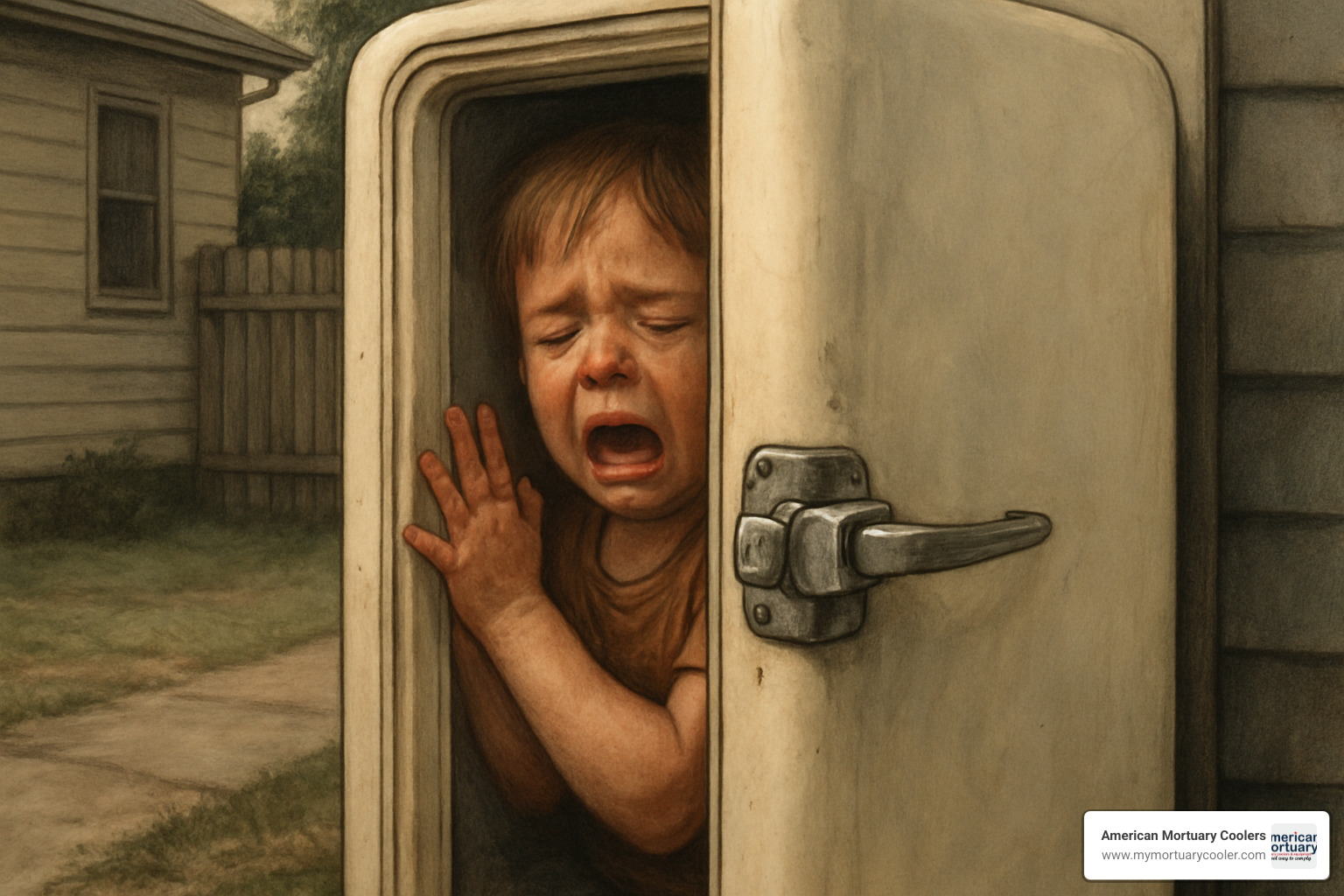
"Refrigerator death" in the news
Despite modern safety improvements, refrigerator death incidents continue making headlines worldwide, reminding us this danger hasn't disappeared:
In South Africa in 2013, three young children (two 4-year-olds and one 3-year-old) died after becoming trapped in an abandoned refrigerator while playing outside their home in Atamelang. Police Sergeant Kealeboga Molale described the heartbreaking scene: "They go into the refrigerator and it looks like the refrigerator locks itself and they suffocated. They were playing outside... and that's how they went into it and died."
More recently in Florida in 2019, three children died after becoming trapped in an unplugged chest freezer. The freezer had a hasp that engaged when the lid closed, sealing the children inside while they played unsupervised.
That same year in Kyrgyzstan, two brothers playing hide-and-seek suffocated after becoming trapped in a Soviet-era refrigerator with an automatic locking system. The model was built so it couldn't be opened from inside – a common and deadly feature of refrigerators from that era.
Scientific research confirms these aren't isolated incidents. A comprehensive California study between 1960 and 1981 documented 471 lethal suffocation cases in children, with refrigerators accounting for 84 of those deaths. Even after safety regulations were implemented, old refrigerators continued claiming lives.
The Scientific research on child suffocation shows that despite educational campaigns and legislation, abandoned appliances remain serious risks, especially in areas where older models might still be in use or improperly discarded.
From Latches to Magnets: The Safety Evolution
The journey from deadly refrigerator latches to safer magnetic seals represents one of the most important consumer safety improvements of the 20th century. This change didn't happen overnight—it was sparked by heartbreaking tragedies and driven by determined public advocacy.
Back in the 1920s, when GE introduced their first "Monitor-Top" refrigerators, no one was thinking about safety. These early models used mechanical latches that created perfect airtight seals. Great for keeping food fresh, but as we now know, potentially deadly for anyone trapped inside.
By the 1950s, refrigerator death had become a genuine epidemic in America. As more families purchased refrigerators and discarded their old models, children increasingly encountered these abandoned units during play. The numbers were staggering—children were dying in what one safety advocate called "steel coffins" left in backyards and dumps.
"We'd find these old refrigerators everywhere," recalled a former health inspector who participated in door removal campaigns. "Behind garages, in vacant lots, sometimes just sitting on the curb. Each one was a potential tragedy waiting to happen."
The watershed moment arrived in 1956 with the Federal Refrigerator Safety Act. This crucial legislation required all refrigerators manufactured after October 31, 1958, to be openable from the inside. Manufacturers settled on magnetic door seals as the solution—strong enough to keep cold air in, but designed to release with about 15 pounds of pressure from inside.
States like Oklahoma, California, and Washington went even further, making it illegal to discard refrigerators without removing their doors first. Violations became misdemeanors, showing how seriously communities took this threat.
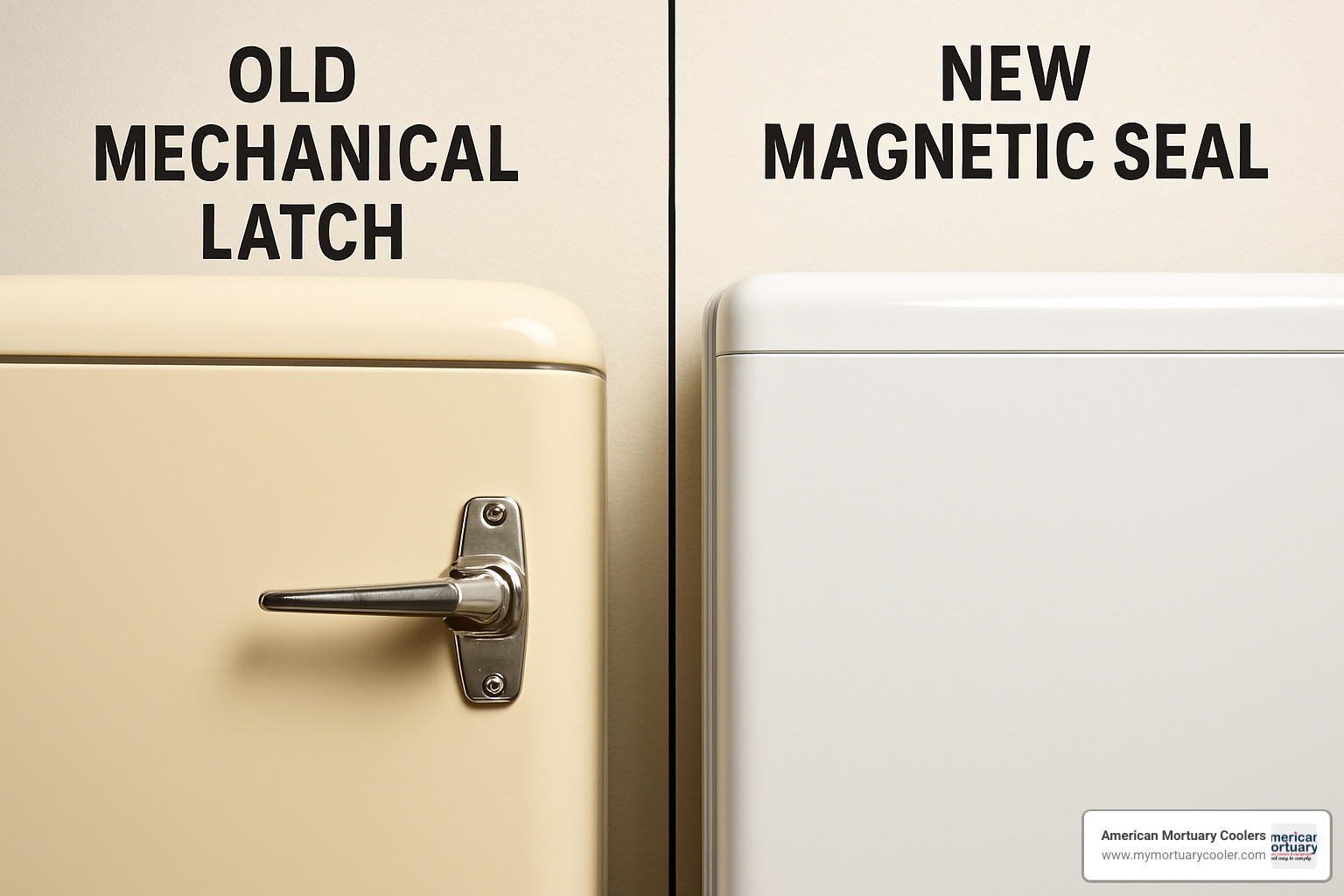
The difference between old and new designs was literally life or death:
| Feature | Pre-1958 Refrigerators | Post-1958 Refrigerators |
|---|---|---|
| Door Mechanism | Mechanical latch | Magnetic seal |
| Interior Release | None | Can be pushed open from inside |
| Force Required to Open from Inside | Impossible | Approximately 15 pounds |
| Risk of Entrapment | Extremely high | Significantly reduced |
| Legal Status | No longer manufactured | Standard for all new units |
"That simple change—from mechanical latches to magnetic seals—has saved countless young lives," explains safety engineer Thomas Keegan. "It's a perfect example of how thoughtful regulation can solve deadly problems."
"Refrigerator death" statistics 1946-1984
The numbers tell a powerful story about both the scale of the tragedy and the effectiveness of the safety solutions.
Between 1946 and 1956, at least 115 children died from refrigerator entrapment in the United States. Looking closer at just January 1954 to June 1956, 54 children were trapped in household refrigerators, with 39 of them dying.
Even after the Safety Act passed, the danger persisted while old models remained in circulation. From 1956 to 1964, another 163 refrigerator death cases were reported nationwide—but significantly, every single one involved pre-1958 models with the dangerous mechanical latches.
The problem was stubbornly persistent. Between 1973 and 1984, decades after the safety regulations, another 96 refrigerator suffocation deaths occurred, all in old-style units that hadn't been properly disposed of.
A detailed California study covering 1960-1981 revealed something even more sobering: among 471 child suffocation deaths in the state, refrigerators caused 84 fatalities—second only to plastic bags as a suffocation hazard.
In just one year—1961—New York health inspectors found and disabled 554 abandoned refrigerators by breaking their locks or removing doors. Each one represented a potential tragedy averted.
Public education & PSAs
While engineering solutions were vital, public education campaigns played an equally important role in preventing refrigerator death incidents.
The 1971 UK public information film stands out for its effectiveness—and frankness. Many adults today still remember how its stark imagery made a lasting impression on them as children. "I never forgot that film," recalls Linda Mercer, now a safety advocate. "It made me genuinely afraid of old refrigerators, which was exactly the point."
Community action was equally important. Throughout the 1950s, concerned citizens organized volunteer efforts to neutralize abandoned refrigerators. Volunteers would comb junkyards, empty lots, and rural areas, removing doors or destroying latches on discarded units.
"We'd go out in teams on Saturdays," remembers retired police officer Jim Hartman. "The local paper would publish our 'score' each week—how many refrigerators we'd made safe. It became a source of community pride."
Research by the Canadian Paediatric Society later confirmed that the most effective campaigns used simple, action-oriented messaging with clear instructions:
Remove doors completely from any refrigerator you're discarding.
Secure refrigerators that are in storage or awaiting pickup.
Teach children about the dangers of playing in or around appliances.
These public education efforts complemented the engineering improvements, creating a two-pronged approach to safety. But as recent tragedies remind us, this education needs to continue with each new generation of parents and children.
The story of refrigerator safety shows how determined advocacy, smart regulation, and community awareness can come together to solve deadly problems—a lesson that applies to many other household dangers we face today.
Modern Risks & How to Prevent Them
Despite all the safety advances we've made, dangerous situations involving refrigerators still exist today. Understanding these risks isn't just important—it could save a life.
Those old pre-1958 refrigerators with mechanical latches? Many are still out there, abandoned in junkyards, rural areas, or sitting forgotten in someone's garage. These vintage units retain their deadly design flaws decades after manufacture, silently waiting to become a tragedy.
Chest freezers present another serious hazard. Unlike upright models, they typically have heavy lids that can be challenging for a small child to push open from inside. Even more concerning are models with hasps for padlocks—these can accidentally snap shut when the lid closes, creating an inescapable trap.
"We see similar dangers in other household appliances," warns the U.S. Consumer Product Safety Commission. Washers, dryers, combination units, picnic coolers, camper ice boxes, and even toy chests with heavy lids all share that same deadly potential for entrapment.
There's also a risk many people never consider—tipping refrigerators. In a heartbreaking Los Angeles case, a man in his sixties lost his life when his refrigerator tipped over as he reached for a drink in his garage. Unlike kitchen refrigerators that typically nestle securely between cabinets, garage and basement units often stand alone without proper anchoring.
The danger intensifies in rural and developing areas where older models remain in use longer and proper disposal facilities might be miles away. Children playing without supervision in areas where appliances might be abandoned face particular risks.
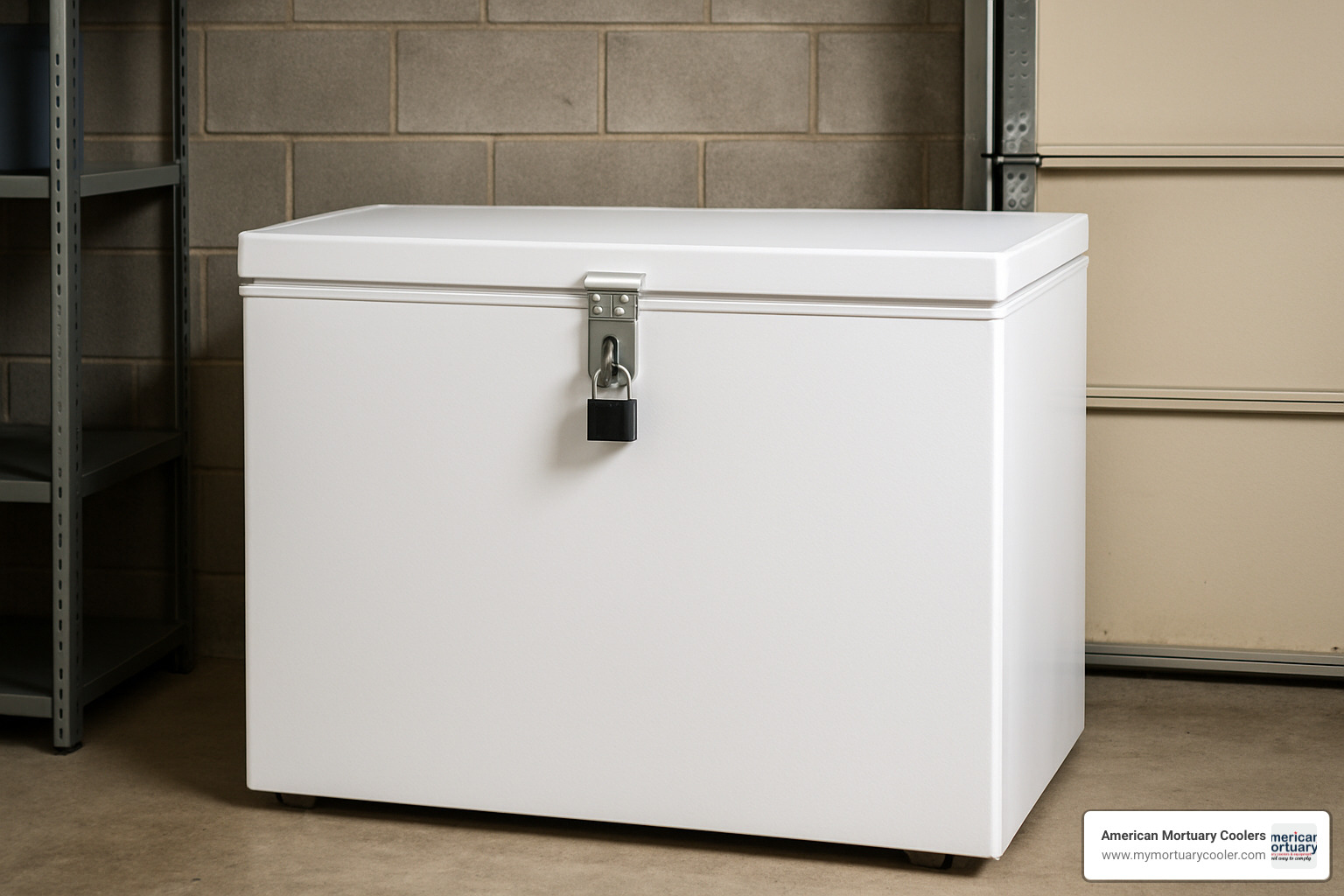
Current refrigerator death scenarios
Despite safety improvements, several scenarios continue to result in refrigerator death cases today:
Abandoned units remain one of the biggest dangers. The 2013 South Africa tragedy where three young children died while playing highlights how discarded refrigerators in vacant lots or rural areas can become deadly playgrounds when their doors remain attached.
Even unplugged appliances pose serious risks. The 2019 Florida incident where three children lost their lives in an unplugged chest freezer shows how quickly a game can turn fatal when a hasp accidentally engages.
Unstable refrigerators create another hazard entirely. Particularly in garages or basements where they aren't secured by surrounding cabinetry, these heavy appliances can tip over when opened. A Los Angeles man tragically lost his life this way when his refrigerator toppled as he reached for a beverage.
While most refrigerator death cases are heartbreaking accidents, there have been documented instances of adults using refrigerators for suicide. These cases typically involve deliberately sealing the unit with tape, as in William B. Moore's case, who left a final note in his diary: "Goodby, thanks, and love."
In parts of the world where older refrigerators remain common, mechanical latches continue claiming lives. The 2019 Kyrgyzstan case involved children trapped in a Soviet-era refrigerator specifically designed to prevent opening from inside—a deadly feature that modern safety standards have eliminated.
At American Mortuary Coolers, we've studied these tragedies extensively to ensure our professional-grade refrigeration units incorporate multiple safety features, including emergency interior release mechanisms, preventing similar incidents in mortuary settings.
Step-by-Step Prevention Checklist
Preventing refrigerator death requires awareness and action. Here's how you can protect your loved ones and community:
Always remove doors from discarded refrigerators. This simple step completely eliminates the entrapment risk and should be your first priority before disposal. The door removal process isn't complicated—disconnect power, remove hinges, and separate the door from the unit.
Disable latches on stored appliances if you're keeping an old refrigerator temporarily. Remove or disable any latching mechanisms that could potentially trap someone inside.
Secure freestanding refrigerators against tipping using anti-tip brackets, especially in garages or basements where they lack the support of surrounding cabinetry. This simple hardware can prevent deadly accidents.
Consider childproof locks for households with young children. These allow adults to access the refrigerator normally while preventing unsupervised access by curious little ones.
Never leave young children unsupervised near refrigerators, freezers, or laundry appliances. A moment of curiosity can lead to a lifetime of regret.
Keep utility rooms locked if they contain appliances that might pose entrapment risks. A simple childproof doorknob cover or hook-and-eye latch placed high on the door can be enough.
Talk with children about the dangers in age-appropriate ways. Help them understand why appliances aren't playgrounds and teach them to tell an adult immediately if they find an abandoned appliance.
Report unsafe products to the Consumer Product Safety Commission at SaferProducts.gov or by calling (800) 638-2772 if you encounter a refrigerator with an unsafe design.
Use certified appliance recycling services that follow proper safety protocols, including environmentally safe handling of refrigerants and proper door removal.
Check the CPSC recall list before purchasing used appliances to ensure the model doesn't have known safety issues.
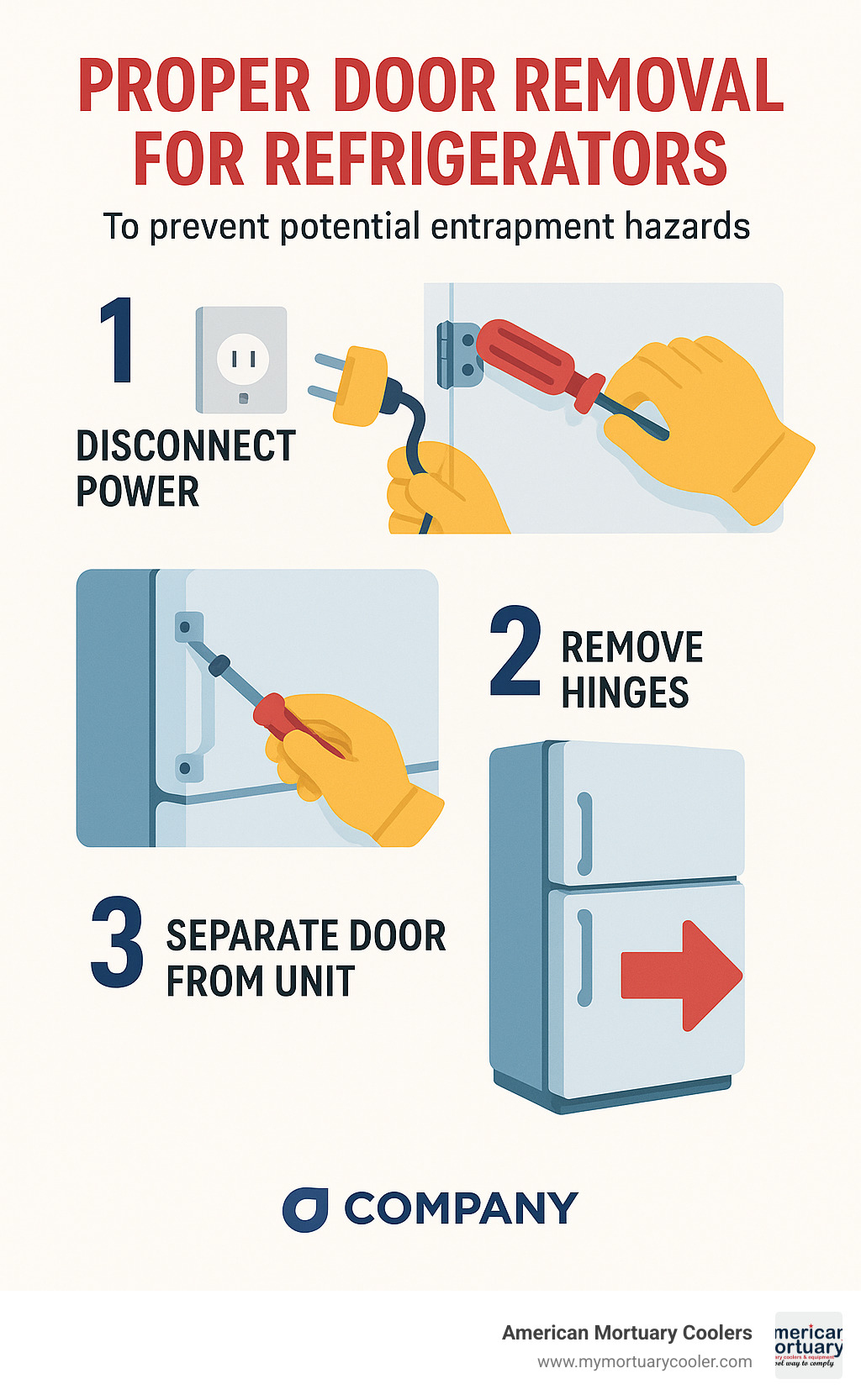
Legal requirements & disposal rules
The laws around refrigerator disposal exist for good reason—they save lives. Understanding these requirements helps ensure you're not unintentionally creating danger.
The Federal Refrigerator Safety Act of 1956 stands as the foundation of these protections. This important legislation made it illegal to manufacture or transport refrigerators that cannot be opened from inside. Any refrigerator made after October 31, 1958, must feature doors that can be pushed open with reasonable force from the inside.
Many states and municipalities have their own regulations that go even further. Oklahoma, California, and Washington have classified improper refrigerator disposal as a misdemeanor—you could face legal consequences for negligence. Some local ordinances require removing doors before placing refrigerators at curbs for pickup, while others impose fines for leaving refrigerators accessible with doors attached.
The Environmental Protection Agency also regulates refrigerator disposal due to harmful refrigerants and foam insulation. Proper recycling must include safe removal of refrigerants, door removal before processing, and appropriate handling of hazardous components.
Despite these laws, enforcement remains challenging. Rural areas and places with limited disposal options often see higher rates of improper refrigerator abandonment. That's why personal responsibility and community awareness are so important.
At American Mortuary Coolers, we understand the critical importance of proper equipment handling. While our professional-grade mortuary coolers incorporate multiple safety features, we still advise our clients on proper decommissioning procedures when units reach end-of-life.
For professional settings dealing with specialized cooling equipment, additional safety protocols may be necessary. Our team can provide guidance on Essential Safety Protocols for Morgue Freezers to ensure both operational safety and proper end-of-life handling.
Frequently Asked Questions about Refrigerator Death
Can a modern fridge really trap you?
Modern refrigerators have come a long way from their dangerous predecessors. If you've purchased a fridge made after 1958, you'll find it uses magnetic seals rather than those deadly mechanical latches of the past. These magnetic doors can typically be pushed open from the inside with about 15 pounds of force—something most children and adults can manage without too much trouble.
That said, there are still some important things to keep in mind:
First, those pre-1958 refrigerators with mechanical latches are absolutely still dangerous if you happen to come across one. They're becoming rare, but they're still out there in garages, basements, and rural areas.
Chest freezers also deserve special caution. Even modern ones use heavy lids, and some include hasps that could accidentally lock into place if the lid falls shut while someone is looking inside.
There's also the human factor to consider. Very young children, elderly folks, or people with physical limitations might struggle to push hard enough to open a door from the inside, especially if they're scared or confused. And if someone doesn't realize pushing would free them—particularly in a dark, enclosed space—they might not even try before panic sets in.
As safety expert Cecil Adams puts it: "Modern fridges are designed to allow escape, so you will survive if you can push inside the door." Those last five words make all the difference.
How long until suffocation occurs?
The timeline for suffocation inside a sealed refrigerator is frighteningly short. According to documentation from a 1976 Herrig Insurance Company advertisement: "A child becomes unconscious in ten minutes and dies within twenty-five minutes." This isn't just one isolated reference—this timeline appears consistently across multiple studies of refrigerator death cases.
Several factors can affect how quickly this happens:
The size of the refrigerator matters—larger units contain more oxygen to start with, but still become deadly within a similar timeframe. The person's size and age also play a role. Smaller children consume less oxygen but have smaller lung capacity and tend to panic more quickly, which increases their breathing rate.
Temperature is another factor, especially in freezers where extreme cold can cause hypothermia before oxygen depletion becomes the primary concern. How much someone moves around inside makes a difference too—struggling or panicking burns oxygen faster, potentially shortening the time to unconsciousness.
People with pre-existing respiratory conditions may experience the effects more rapidly than others.
The takeaway here is sobering: refrigerator entrapment creates a life-threatening emergency within minutes, not hours. This explains why many victims cannot be rescued even when family members notice they're missing relatively quickly.
What other appliances pose the same danger?
Your home likely contains several other items that present similar risks to refrigerators. Being aware of them could save a life.
Chest freezers might actually be the most dangerous appliances after refrigerators. Their heavy lids can be difficult to push open from inside, and some models include hasps for padlocks that can accidentally snap shut.
Front-loading clothes dryers often fascinate small children as hiding places, but can be tricky to exit if the door closes completely. Combination washer/dryer units typically have secure latching mechanisms and are often tucked away in utility rooms where cries for help might go unheard.
Large picnic coolers can create surprisingly airtight environments if closed with someone inside. Ice boxes in campers and RVs, especially older models, often feature secure latches designed to prevent opening during travel.
While not technically appliances, car trunks present very similar risks. In 1998 alone, eleven children died in a single month after becoming trapped in car trunks, which prompted new safety requirements.
Even toy chests with heavy lids can close suddenly, potentially trapping children inside. The common thread connecting all these hazards is that they create airtight or nearly airtight spaces, have insulated construction that muffles sounds, feature self-latching or heavy closure mechanisms, and often look like fun hiding places to children.
At American Mortuary Coolers, we take these consumer safety lessons seriously. We've applied what's been learned from these tragic incidents to design our professional-grade mortuary refrigeration systems with multiple safeguards against accidental entrapment, ensuring both safety and functionality for the professionals who rely on our equipment.
Conclusion
The story of refrigerator death is both heartbreaking and hopeful. It shows how we've learned from tragedy to create safer homes for our children. While modern refrigerators are much safer than their predecessors, abandoned appliances and certain designs still pose real dangers that we can't afford to ignore.
Throughout this article, we've finded some crucial lessons:
Old refrigerators aren't just outdated—they're deadly. Those pre-1958 models with mechanical latches remain silent killers if not properly disabled before disposal. Even decades later, these relics continue to claim lives when improperly discarded.
Today's refrigerators with magnetic seals have dramatically reduced risks, but we shouldn't get complacent. Chest freezers, washers, dryers, and other appliances can still create dangerous situations, especially for curious children.
Perhaps most chilling is how quickly tragedy can unfold. When someone becomes trapped in an airtight appliance, they can lose consciousness within just ten minutes and die within twenty-five. This rapid timeline explains why even brief moments of inattention can lead to heartbreaking outcomes.
Thankfully, prevention is straightforward. Removing doors before disposal, supervising children around appliances, and securing units against tipping can eliminate most risks. These simple steps save lives.
The Federal Refrigerator Safety Act and various state laws weren't created on a whim—they reflect the serious nature of these hazards and the painful lessons learned through preventable deaths.
At American Mortuary Coolers, safety is woven into everything we do. Our Tennessee-based team designs and manufactures custom mortuary refrigeration systems with multiple safeguards like internal release mechanisms and door ajar indicators. These features prevent accidental entrapment while maintaining the precise temperature control that funeral homes and medical examiners depend on.
We serve clients throughout the continental United States, delivering specialized refrigeration solutions that incorporate the highest safety standards. Our commitment to safety isn't just about compliance—it's about honoring the lessons learned from history's tragic refrigerator accidents.
If there's one thing to remember from this article, it's this simple rule: door off before drop-off. Never discard a refrigerator, freezer, or similar appliance without first removing its door or disabling its latching mechanism. This small action could save a child's life.
For more information about our safety-focused mortuary refrigeration solutions, please visit our resource on morgue cooler solutions.


















